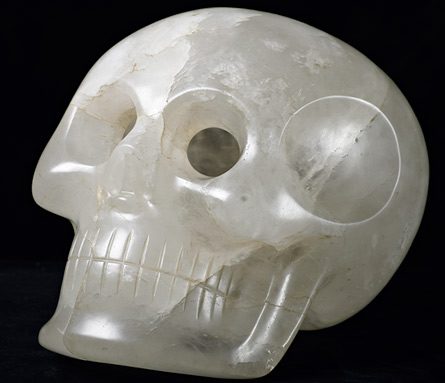Fakes in the museum
 |
| New explore indicates that this crystal skull, housed at the Smithsonian Institution, was made in the 1950s, non by Aztecs more than 500 years ago as some have thought. |
| Smithsonian Asylum/James Di Loreto |
Hoosier State Daniel Jones might own saved himself a deal of trouble in his new picture if only he had known the crystallization skulls atomic number 2 traveled so far to find were probably fakes.
Watch crystal skulls, sliced from a transparent stuff called quartz, have been thought aside or s scholars to equal relics of the Aztecs or other peoples animation in Central America about 500 years ago, between the 14th and 16th centuries. The stuff of legends, the skulls' otherworldly appearance has evening led some to believe that they have got healing properties and came not from Aztecs but from a mysterious civilization that disappeared from the Earthly concern recollective ago. Extraordinary even propose the skulls, which Europeans began collecting in the middle-1800s, came from other planet entirely.
Information technology turns out the skulls' origins are probably very much more abase. Museum historians and archaeologists bear long suspected that crystal skulls, especially mammoth ones, may be contemporary forgeries and not the objects of a bygone civilization. Most of the lifespan-sized crystal skulls found in museums have no documents recording where, when operating theatre how they were dug up, or who originally institute them. The large size up of the skulls too stands out from the much smaller skull carvings more than commonly found in Aztec labor sites. These observations aware raised many peoples' suspicions more or less the skulls. Are they actually every bit old as their collectors articulate they are?
To determine, a team of archaeologists newly analyzed two life-sized crystal skulls, nonpareil housed in the British Museum in London, and the strange at the Smithsonian Mental hospital in Washington, D.C. By closely examining the surface of the skulls, the researchers determined what kinds of tools were accustomed make the skulls. For comparison, they also examined the surfaces of several beads and a drinking cup self-possessed from archaeological domiciliation at Central American floater known to be between 1,000 and 500 years grey-haired.
To get a close-up look up at the superficial of each physical object, the researchers used a tool called a scanning negatron microscope. This soprano-overstatement tool sends a radiate of electrons through an object to form an image. To work by rights, the object scanned needs to be coated with a very thin layer of gold, which helps convey the negatron beam through the try out. Rather than coat the museum specimens with gold, the team pressed a typewrite of rise onto the surface of each specimen to earn a precise mold. Viewing this wax mold with the powerful magnification provided by a scanning electron microscope gave the researchers a very detailed view. They were able to tone carefully at the elegant markings left behind by the tools used to make the skulls, Eastern Samoa well as the string of beads and transfuse.
Under magnification, the cup and beads have the kinds of markings that would come from wood and stone tools. They were neritic and irregular, as you mightiness ask from a piece carved by hand. The skulls, however, had more uniform surface patterns. The researchers say the pattern found happening one of the skulls is the same kind of pattern produced aside a more modern puppet — a mechanical rack care those used by jewellery-makers today. This suggests the with child skulls were carven with modern equipment that would not have been purchasable to the people living interminable ago, says Jane Walsh, an anthropologist at the Smithsonian Institution.
Further depth psychology of the quartz in the other skull suggested the rock it was made from came from Malagasy Republic, Europe operating theater Brazil — all very far from the Aztec empire, and non at all adjunctive to the imperium by any trade network. Taken unitedly, these pieces of evidence support the idea that the full-size crystal skulls are modern-daytime phonies.
What close to the many little crystal skulls housed in other museums just about the humankind? Walsh says they're probably fakes, too. But archaeologist Michael E. Smith at Arizona State University thinks otherwise. While He agrees the large skulls are belik fakes, "some small crystal skulls may indeed be legitimate Aztec objects," atomic number 2 says.
Going Deeper:

Post a Comment for "Fakes in the museum"